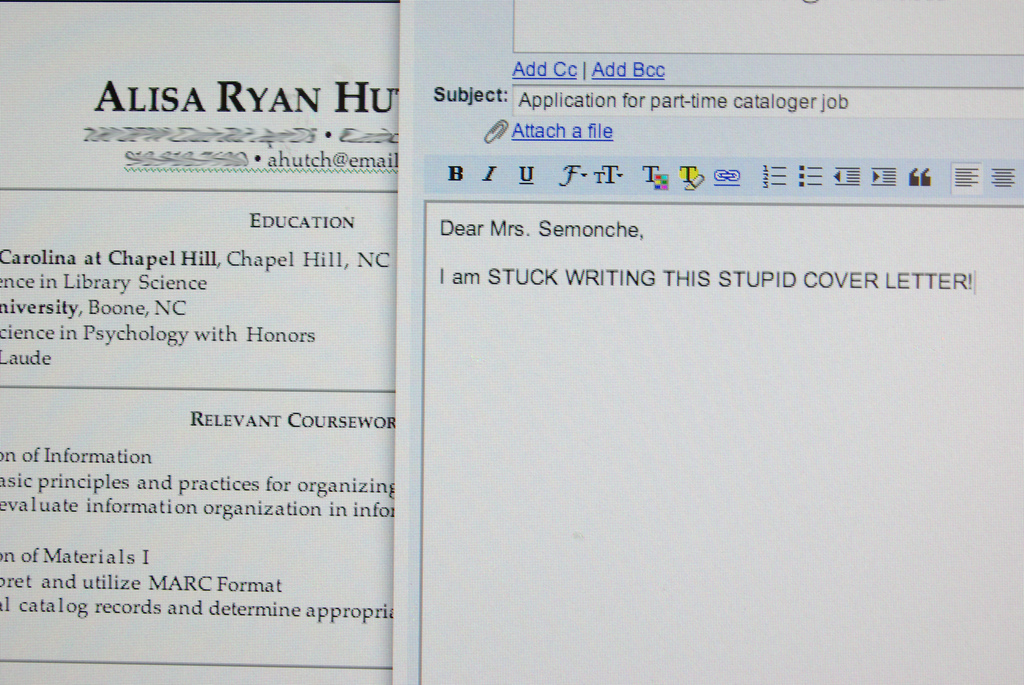Here's a synopsis of what I shared with my JOUR 1100 class on Wednesday, with instructions for the 14 students to each write by next week a one-page, five-paragraph cover letter for the position they want this summer:
First, the essentials, starting with 1-inch margins all around. Except in two places, the font will be Times New Roman and 12 point. Next, the letterhead – be sure to have one. Three lines, centered, with your name, in bold, on the first line. (Here's the first of the two exceptions: raise the name's point size to 14, 16 or 18.) The second line should be where you can be found on earth, that is, your street address and telephone number. The third line is for where you are in the digital universe (website or blog address, LinkedIn, Twitter, Cuttings.me, etc.).
From here, it's all block style, that is, aligned left with spaces between paragraphs. Skip a line and place the date. Skip another line and declare to whom and where you're writing. This should be five lines: name, position, company and address (city, state and zip code goes on the fifth line). Skip another line and apply the greeting, with a prefix, last name and colon. Don't use To Whom It May Concern. If the application instructions say to send to human resources or to a generic email address, show that you can do a little research. It should be easy to find out who at the company most likely will decide who gets picked for the job or internship. Address your letter to that person.
The first paragraph should be two sentences. The first states who you are and where you're from – I am a junior majoring in journalism at the Diederich College of Communication at Marquette University in Milwaukee. The second states what you want and where – I am applying for a metro desk internship this summer with (company name) in (location). This paragraph should be no longer than three lines. The second, third and fourth graphs are the most important. Save room for them. Oh yes, my students know that I don't tolerate widows and orphans.
The second paragraph is for your campus experience. For journalism students, this means student media and or exceptional course achievements. The third paragraph is for what you have done away from school, as in previous internships or other co- or extracurricular activities. Your fourth paragraph is where you really distinguish yourself. Let's assume that everyone else applying for the job you want has been busy with student media and had at least one internship. This is where you show that who you are and what you have done are truly remarkable. Did I say show? Remember, don't tell me! Show me! That goes for the second, third and fourth paragraphs.
The fifth paragraph is key, too. It's also two sentences. The first is easy – Thank you for considering my application. The second keeps the ball in your court (excuse the cliche) – I will contact you soon to confirm receipt. They should fit on one line; that leaves more room for the three preceding paragraphs. Also, this is better than telling the reader to feel free to contact you. Remember who wants the job. Be sure your letter reaches its destination.
Finally, let's close the letter in style. Skip a line and write Sincerely, then type your name on the next line, and then your name again on the line underneath it. Now it's time for the second font exception mentioned above: Select your name on the line beneath the salutation, change it from Times New Roman to Lucida Handwriting, and raise the point size to 14 or 16. This will give the impression of an electronic signature. That's it. You're done.
Oops! No, you're not. Proofread your letter, not once, not twice, but three times. Put it down. Have someone else you trust read it for you. Then read it again. Make sure it abides by AP style and correct grammar, spelling and punctuation. You have worked too hard on this and all your efforts so far to lose out because of stupid mistakes.
Well, that's all I have for now. I make no guarantees that following my advice will automatically secure the job or internship or scholarship you want. This is about style and formatting. What really matters is what you have for the second, third and fourth graphs. That's up to you. No cover letter can cover up for lack of substance.
I hope to soon offer tips for crafting resumes. For now, review these links from recruiting guru Joe Grimm: Tips for Avoiding Four Common Punctuation Errors on Resumes and The Top Six AP Style Errors on Resumes. Oh yes, as I tell my students, whether it's a cover letter or resume, the most important thing – show me you can write!

 RSS Feed
RSS Feed
